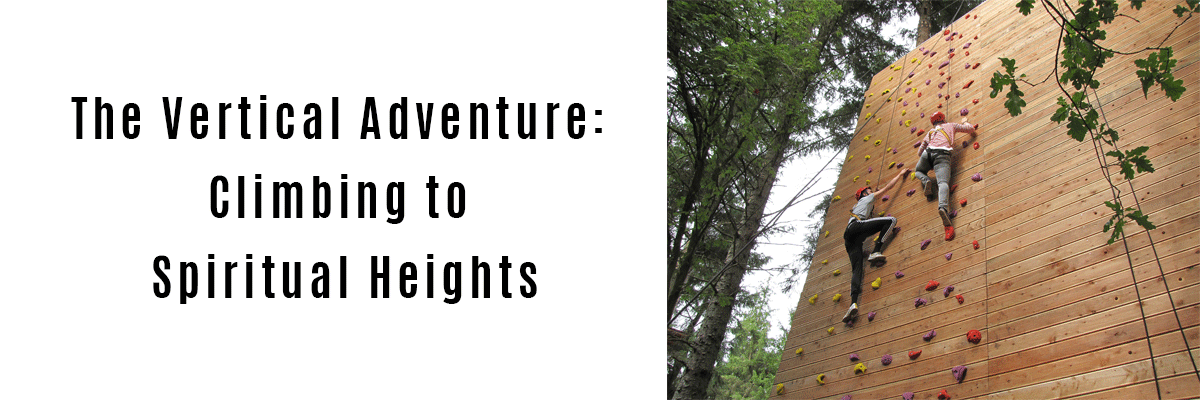by Ramesh Richard
Wall-climbing, literally and figuratively, drives me up a wall. This may be hard to believe, but after much convincing, I tried my hand at climbing a wall. A recreational sport marketed to the young and adventurous, wall-climbing requires sheer physical effort on one level, but on a gut level elicits frustration, irrational thoughts, and even fear of heights from novices like me.
We were at the climbing wall of the Castaway Young Life camp in Northern Minnesota, and my children easily and eagerly mixed adventure with novelty, trusting their entire destiny to a belayer. In contrast, I chose the least threatening 40-foot climb. Though completely harnessed, I groped the rope tightly for fear of falling. I searched strategically-placed knobs of rocks for surer footing. Bolted to the wood, these rocks of different sizes and shapes, of odd widths and colors provided the only steps to my ascent. My worn-out jeans protected my weary legs and bony knees from scrapes and scruffs. Repeatedly I pushed away from the wall to prevent my head from knocking on the wood. By the time I reached the top of the loft and arrived at my goal, my hands were red with rope-burn.
I actually learned a lot that day, more so about the spiritual life than wall-climbing. “Climbing the heights,” a scriptural metaphor of the spiritual life, became more real to me.
The “vertical adventure” is a pregnant and powerful comparison to the Christian journey. The Apostle Paul declared: “I press on toward the goal for the prize of the upward call of God in Christ Jesus” (Phil. 3:14). Like the physical vertical adventure, Paul’s description of our spiritual ascent communicates both journey and destination; excitement and hazard; effort and trust; thrill and risk; movement and rest; endeavor and reward. The life of faith is not a horizontal activity or a flat passage, it’s a vertical climb. The spiritual life means scaling the heights, to press forward, toward, and upward.
belay \bi-lā\ n 1: the securing of a person or a safety rope to an anchor point (as during mountain climbing); also : a method of so securing a person or rope 2 : something (as a projection of rock) to which a person or rope is anchored
My personal “belayer” had it all—the equipment, the experience, and the encouragement needed to facilitate my ascent. As I stepped into the harness, hoops, buckles and all, I felt a surge of adrenaline propelled by healthy anxiety. The contraption snugly fit around my thighs and waist. While the harness system covered each person in the same way, it fit me in a unique way. Doesn’t that sound like the salvation anchor and harness that God personally provides for our spiritual adventure? His grace covers all in the same way—through believing on the Lord Jesus Christ as one’s only God and Savior. But Jesus also salvifically covers our particular contours—our unique histories, experiences, and sins. Through faith we personally step into God’s harness that will carry us up the rampart.
The physical climb begins in faith, faith in the belayer who devised, guarantees, and controls the belaying system. That initial faith demands much from us. Many first-time climbers hesitate to trust a stranger so completely. It is much like trusting a man who was born 2000 years ago in a remote Jewish village, who lived a flawless life, voluntarily died, and raised himself from the dead. Trusting in a complete stranger is hard enough at the beginning, a good reason why God doesn’t frontload the gospel with additional conditions. That day I saw people arriving at the top, some suspended clumsily, others laughing joyfully, many struggling and puffing hard. Truly, the struggles of the many gave me pause, while the accomplishments of older men encouraged me to trust the belayer and the belaying system for myself. I decided to make the climb.
The Check-list: Orthodoxy
Tied in, tied up, and tied together, the belayer and I went through the final check list: Are buckles in place and doubled? Is the harness rightly tied? Is the belayer anchored in the right way to the floor? The checklist exercise parallels Christian orthodoxy—checking in order to believe the right things. To start the Christian life, we believe that certain realities, propositionally stated, and independent of my opinions, must be trusted as true. Orthodoxy is both cognitive and objective. Without this transfer of trust to a salvation system anchored to the Divine Belayer, there is no spiritual harness at all.
We can check the spiritual life manual (God’s Word) to see whether our beliefs correspond to it.
The Checklist Exercise
- Is Jesus’ salvation claim state-able, understandable, and believable? Of course it is—the only one of its kind in the world of salvation options.
- Is Jesus’ system of security rightly anchored? Indeed, it is—in the unshakeable, immutable God himself.
- Is the system adequate for the journey? Certainly so—the system of the Cross was brilliantly conceived in the wisdom of God, grounded in the justice of God, executed by the love of God, and structured around the power of God for life’s climb.
We believe the truth that is written to assure us of eternal life (1 John 5:13). We step into the harness by believe rightly. Have you checked the checklist above for yourself?
Beginning the Vertical Adventure: Orthopraxy
Having stepped into the harness, you can still decide to stay on the ground. But what good is that? Many Christians start out by believing in the Lord Jesus, but then get distracted by what is happening on the floor, developing relationships with others who have decided to stay and play on the ground. They do not move on from elemental truths to maturity, from basic truth to growth, from orthodoxy into orthopraxy. Orthopraxy deals with the practice of what one believes, to begin the climb of faith by faith. We not only receive salvation through faith, but we ascend the heights by faith in the Belayer to hold us up as we go up.
Each pair of climber and belayer audibly practiced their climbing calls precisely and rhythmically.
“On rope 4,” I called out.
He replied, “On belay 4.”
The vertical adventure had begun. By faith,—even as I looked at the daunting climb, I wondered how I ever got it into this, questioned my personal judgment, felt tempted to stay down on the ground, and marveled at how the others did it—I shouted, “Climbing.”
To which my belayer echoed, “Climb on.”
With that encouragement, I received his assurance that all will be alright. He would be watching out for me. Onlookers gathered around a middle-aged professor shedding his academic demeanor, dangling clumsily in the air, speculating on which rock would hold me up. First, they shared in surprised whispers, and then began to cheer me on. From the ground, they even got involved and pointing to options for heel and hand around me. The first few feet were easy. I called for “slack” (more rope), and the belayer gave me slack. I was tempted to stay close to the floor in a no-risk area. A little later, I asked him to “up the rope” to tighten the slack, to insure me against my feeling of falling. He gently let me know I needed assurance that he had me in focus, not mere insurance that all was well taken care of. While the crowd around me lost interest in my crawling effort—they went on to other matters—the belayer had only one person in mind. Me!
A function of divine omniscience, God is able to focus on you as though you were the only person on the rope climbing the wall of faith in faith. He cannot get distracted and does not lose interest in you (Ps. 121:1-8). He can belay each one of us as though there were only one of us because He is God. Only one cry from the climber does not elicit a response from the belayer—“Falling!” Why? Because while you may experience the feeling of free fall, you won’t hit the ground and be dashed to pieces. The alert Belayer upholds you (Ps. 37:23-24). All that He has to do is to adjust the rope in His firm grip.

Continuing the Vertical Adventure: Orthopathy
We harness through faith in the belayer (orthodoxy), we climb in faith (orthopraxy), and we continue by faith (orthopathy). The ultimate “faith climb” translates orthodoxy into orthopraxy connected by orthopathy. You notice a passionate commitment (orthopathy) to believing conviction (orthodoxy) in order to practically climb up (orthopraxy) the wall of God’s high expectations. You value and desire what God desires for you. You want to trust God to reach His heights of glory. Your convictions on Biblical truth and Jesus’ value in your life grows.
I made several mistakes on my ascent. For instance, I thought I’d climb the rope straight up but all I gained was severe rope-burn. And when I had to stop and rest, I wanted to simply stay where I was permanently. But then I wasn’t pressing on to the upward call. I could wait due to weariness but not to satisfy my desire for stagnancy.
What was the most important lesson I learned that day? I didn’t have to pull myself up! I had to learn that wall-climbing was not done by pulling myself up, a lesson I’d wished I learned earlier. I thought climbing needed powerful arms and strong shoulders. Instead, those very hands were to be used for balance, those feet used for support, and my hands were needed to keep my body weight over the feet . We could control how fast or slow we wanted to climb. But pulling myself up wore me out! Trying to tighten the rope while climbing encroached on the belayer’s responsibility.
Similarly, in the Christian ascent don’t try to pull yourself up to achieve spiritual godliness. Press on and climb, but don’t pull yourself up. Eyeball the holds, using hands for balance, placing your feet for support, but communicate all the time with the Belayer. That two-way communication keeps from having to pull yourself up. Get out of the belaying role. If you don’t communicate with the Belayer or submit to His direction you’ll assume you are in charge of your climb. The Divine Belayer uses your efforts as mere instruments in your climb. When unmotivated, you’ll simply stop and hang there. Worse yet, when you sin, you’ll regress.
Keep in touch with Him by calling out in prayer and He will direct your hands and feet through His Word. He’ll keep you climbing. He’ll get you up there.
When I got near the peak and was almost there, the adrenalin began to flow again. My will began to rev up. I heard cheers both from the ground and from those who were already atop. The four belay lines climbing with me were encouraging each other.
Once there, I shouted to others on the ground to harness up. Some refused while others responded positively. Those who hesitated while putting on the harness I egged on even more: “You can do it!”
Don’t get into the harness and stay down. You’ll experience wonderful company and pleasant fellowship down there but that’s not why you entered the Christian life. You stepped into the harness to step up the wall. Climbed in to climb up.
Why is wall-climbing so popular? Type “belaying” into your Internet search engine and you’ll find ten pages of pertinent sites. People enjoy the challenge. Experts tell me that the enjoyment of the climb relates strategically, critically, and clearly to my confidence in the belayer and the system. That’s why young children run up those walls in carefree climbing. My careful climbing puts the responsibility of climbing on myself, rather than on both the climber and belayer in differing, demarcated roles. “Except we become as children” in our firm and unflinching trust in the belayer, we will assume his work as ours in addition to our own. Instead, the more our confidence in God, the more our enjoyment of the Christian life. The less our trust in Him, the less the abundant life.
My guide also explained three signs of a worn rope. If the rope gets puffy, the weave is getting loose; when it is shiny and glazed, the rope has been rubbing against the shaggy rocks; or if the rope feels hollow, the rope definitely needs to be retired. If you can equate your faith with the worn rope, you are in deep trouble. On occasion, your faith will be dry, hollow, or puffy—weak and defective. You will be pulling yourself up and wearing yourself out in the process. Instead, our faith must be in the God who designed the system, holds your rope, and empowers your climb as you press on to the prize. The climb is yours by faith; but the clout is His, by nature. Decisions are yours by faith; results are His by promise. The rigor is yours, but the vigor is His.
Don’t weary yourself out. Call on the one who calls out to you, and keep climbing. He’ll tighten the slack, pull you up, and you will reach the top. For “he who began a good work in you will carry it through to completion on the day of Christ Jesus (Phil. 1:6). You will reach up there.
Perhaps the Psalmist had rock-climbing in mind when he confidently remarked on the spiritual life process “God arms me with strength and makes my way safe. He makes my feet like those of a deer and gives me sure footing on high places. (Ps. 18:32-33).
Or like my belayer pointed out, “God’s ‘on belay’ 24 hours a day.” He takes up the slack. He catches you when you fall. He’ll take you up there. Climb on!”






